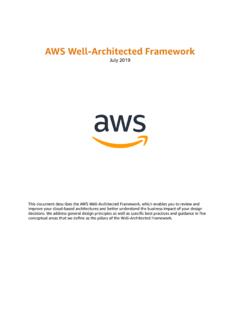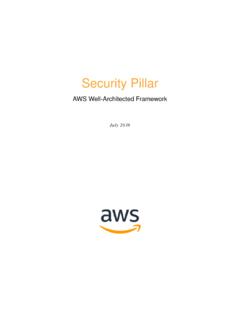Transcription of AWS Reliability Pillar - d1.awsstatic.com
1 Reliability Pillar AWS Well-Architected framework April 2019 Notices Customers are responsible for making their own independent assessment of the information in this document. This document: (a) is for informational purposes only, (b) represents AWS s current product offerings and practices, which are subject to change without notice, and (c) does not create any commitments or assurances from AWS and its affiliates, suppliers or licensors. AWS s products or services are provided as is without warranties, representations, or conditions of any kind, whether express or implied. AWS s responsibilities and liabilities to its customers are controlled by AWS agreements, and this document is not part of, nor does it modify, any agreement between AWS and its customers. 2019 Amazon Web Services, Inc. or its affiliates. All rights reserved. Contents Introduction.
2 1 Reliability .. 1 Design Principles .. 2 Definition .. 3 Foundation Limit Management .. 5 Foundation - 7 Application Design for High Availability .. 13 Understanding Availability Needs .. 19 Application Design for Availability .. 20 Operational Considerations for Availability .. 28 Example Implementations for Availability Goals .. 35 Dependency 36 Single Region Scenarios .. 36 Multi-Region Scenarios .. 44 51 Contributors .. 53 Document Revisions .. 53 Appendix A: Designed-For Availability for Select AWS Services .. 54 Abstract The focus of this paper is the Reliability Pillar of the AWS Well-Architected framework . It provides guidance to help you apply best practices in the design, delivery, and maintenance of Amazon Web Services (AWS) environments. Amazon Web Services Reliability Pillar AWS Well-Architected framework Page 1 Introduction The AWS Well-Architected framework helps you understand the pros and cons of decisions you make while building systems on AWS.
3 By using the framework you will learn architectural best practices for designing and operating reliable, secure, efficient, and cost-effective systems in the cloud. It provides a way to consistently measure your architectures against best practices and identify areas for improvement. We believe that having well-architected systems greatly increases the likelihood of business success. The AWS Well-Architected framework is based on five pillars : Operational Excellence Security Reliability Performance Efficiency Cost Optimization This paper focuses on the Reliability Pillar and how to apply it to your solutions. Achieving Reliability can be challenging in traditional on-premises environments due to single points of failure, lack of automation, and lack of elasticity. By adopting the practices in this paper you will build architectures that have strong foundations, consistent change management, and proven failure recovery processes.
4 This paper is intended for those in technology roles, such as chief technology officers (CTOs), architects, developers, and operations team members. After reading this paper, you will understand AWS best practices and strategies to use when designing cloud architectures for Reliability . This paper includes high-level implementation details and architectural patterns, as well as references to additional resources. Reliability The Reliability Pillar encompasses the ability of a system to recover from infrastructure or service disruptions, dynamically acquire computing resources to meet demand, and mitigate disruptions such as misconfigurations or Amazon Web Services Reliability Pillar AWS Well-Architected framework Page 2 transient network issues. This paper provides in-depth, best-practice guidance for architecting reliable systems on AWS. Design Principles In the cloud, there are a number of principles that can help you increase Reliability : Test recovery procedures: In an on-premises environment, testing is often conducted to prove the system works in a particular scenario; testing is not typically used to validate recovery strategies.
5 In the cloud, you can test how your system fails, and you can validate your recovery procedures. You can use automation to simulate different failures or to recreate scenarios that led to failures before. This exposes failure pathways that you can test and fix before a real failure scenario, reducing the risk of components that have not been tested before failing. Automatically recover from failure: By monitoring a system for key performance indicators (KPIs), you can trigger automation when a threshold is breached. These KPIs should be a measure of business value, not of the technical aspects of the operation of the service. This allows for automatic notification and tracking of failures, and for automated recovery processes that work around or repair the failure. With more sophisticated automation, it is possible to anticipate and remediate failures before they occur.
6 Scale horizontally to increase aggregate system availability: Replace one large resource with multiple small resources to reduce the impact of a single failure on the overall system. Distribute requests across multiple, smaller resources to ensure that they don t share a common point of failure. Stop guessing capacity: A common cause of failure in on-premises systems is resource saturation, when the demands placed on a system exceed the capacity of that system (this is often the objective of denial of service attacks). In the cloud, you can monitor demand and system utilization, and automate the addition or removal of resources to maintain the optimal level to satisfy demand without over- or under-provisioning. There are still limits, but some limits can be controlled and others can be managed (See Foundation-Limit Management). Manage change in automation: Changes to your infrastructure should be via automation.
7 The changes that need to be managed are changes to the automation. We will discuss all these design principals when illustrating scenarios. Amazon Web Services Reliability Pillar AWS Well-Architected framework Page 3 Definition Service availability is commonly defined as the percentage of time that an application is operating normally. That is, it s the percentage of time that it s correctly performing the operations expected of it. This percentage is calculated over periods of time, such as a month, year, or trailing 3 years. Applying the strictest possible interpretation, availability is reduced any time the application isn t operating normally, including both scheduled and unscheduled interruptions. We define availability using the following criteria: Availability = Normal Operation Time / Total Time A percentage of uptime (such as ) over a period of time (commonly a year) Common short-hand refers only to the number of 9 s ; for example, five nines translates to available Some customers choose to exclude scheduled service downtime (for example, planned maintenance) from the Total Time in the formula in the first bullet.
8 However, this is often a false choice because customers might actually want to use your service during these times. Here is a table of common application availability design goals and the possible length of interruptions that can occur within a year while still meeting the goal. The table contains examples of the types of applications we commonly see at each availability tier. In this document, we will refer to these values. Availability Max Disruption (per year) Application Categories 99% 3 days 15 hours Batch processing, data extraction, transfer, and load jobs 8 hours 45 minutes Internal tools like knowledge management, project tracking 4 hours 22 minutes Online commerce, point of sale 52 minutes Video delivery, broadcast systems 5 minutes ATM transactions, telecommunications systems Amazon Web Services Reliability Pillar AWS Well-Architected framework Page 4 Calculating availability with hard dependencies.
9 Many systems have hard dependencies on other systems, where an interruption in a dependent system directly translates to an interruption of the invoking system. This is opposed to a soft dependency, where a failure of the dependent system is compensated for in the application. Where such hard dependencies occur, the invoking system availability is the product of the dependent systems availabilities. For example, if you have a system designed for availability that has a hard dependency on two other independent systems that each are designed for availability, the system can theoretically achieve availability: invoking system * dependent 1 * dependent 2 = * * = It s therefore important to understand your dependencies and their availability design goals as you calculate your own. Calculating availability with redundant components. When a system involves the use of independent, redundant components (for example, redundant Availability Zones), the theoretical availability is computed as 100% minus the product of the component failure rates (100% minus availability.)
10 For example, if a system makes use of two independent components, each with an availability of , the resulting system availability is > : maximum availability - ((downtime of dependent 1) * (downtime of dependent 2)) = 100% - ( * ) = But what if I don t know the availability of a dependency? Calculating dependency availability. Some dependencies provide guidance on their availability, including availability design goals for many AWS services (see Appendix A: Designed-For Availability for Select AWS Services). But in cases where this isn t available (for example, a component where the manufacturer does not publish availability information), one simple way to estimate is to determine the Mean Time Between Failure (MTBF) and Mean Time to Recover (MTTR). An availability estimate can be established by: Availability Estimate = MTBF / (MTBF + MTTR) Amazon Web Services Reliability Pillar AWS Well-Architected framework Page 5 For example, if the MTBF is 150 days and the MTTR is 1 hour, the availability estimate is For additional details: This document can help you calculate your availability.
















